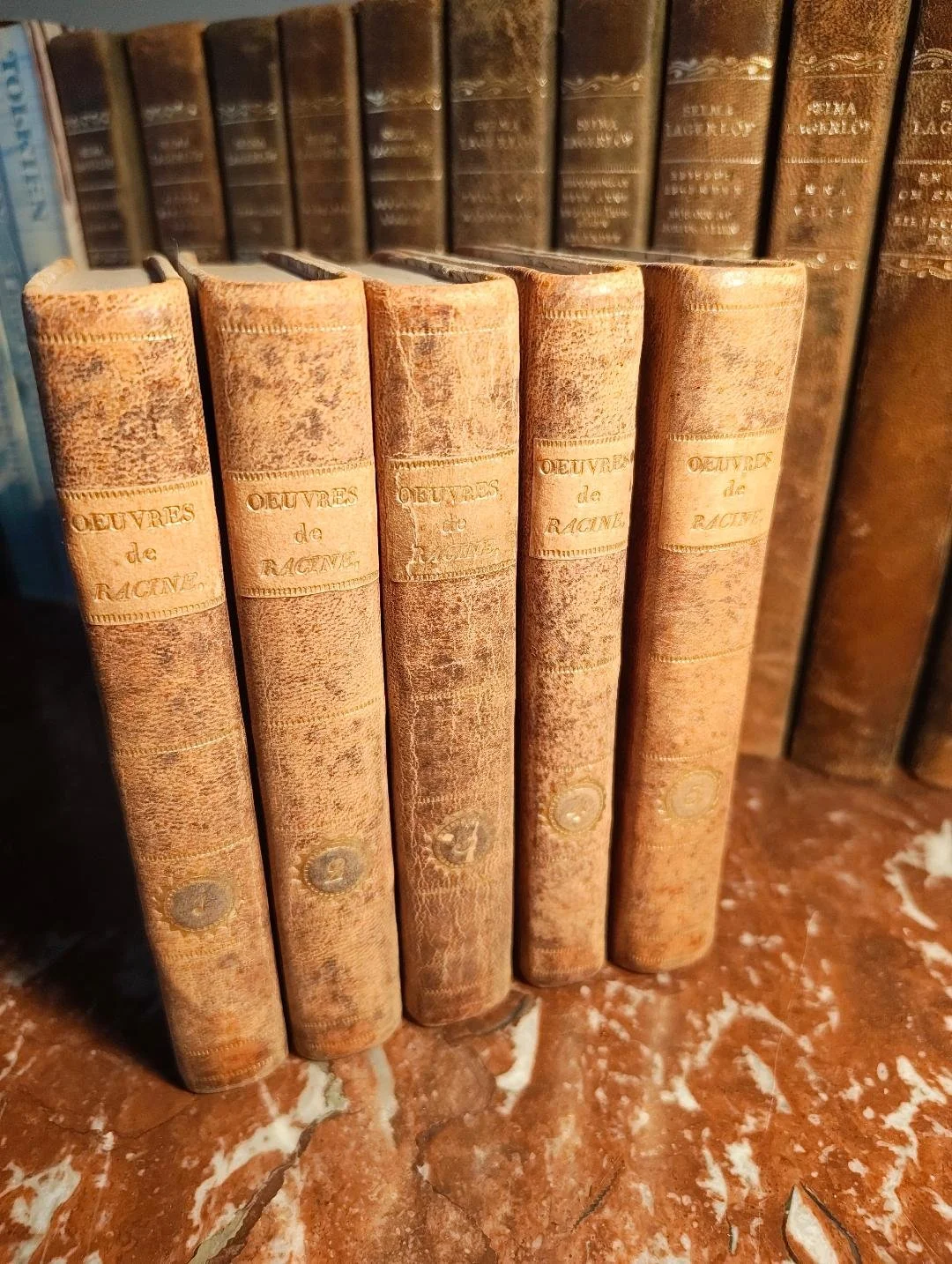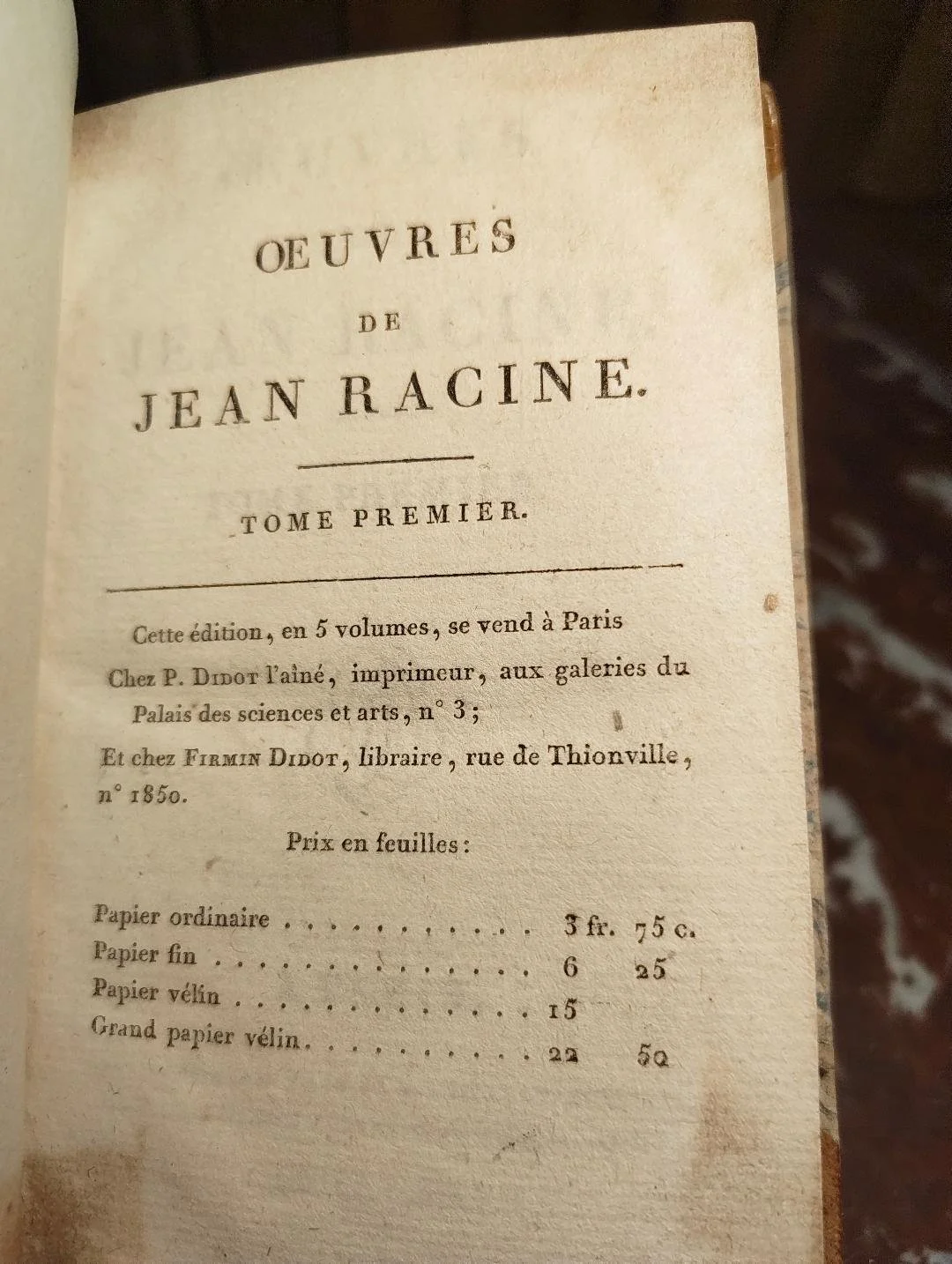 Image 1 of 8
Image 1 of 8

 Image 2 of 8
Image 2 of 8

 Image 3 of 8
Image 3 of 8

 Image 4 of 8
Image 4 of 8

 Image 5 of 8
Image 5 of 8

 Image 6 of 8
Image 6 of 8

 Image 7 of 8
Image 7 of 8

 Image 8 of 8
Image 8 of 8









Jean Racine – Œuvres Complètes. Paris, Didot, An XI (1803). Five Volumes in Matching Half-Leather Bindings
A refined early Didot stereotype edition of France’s greatest tragedian
This complete five-volume set of Œuvres de Jean Racine, printed in Paris in the eleventh year of the French Republic (1803) by Pierre Didot l’aîné and Firmin Didot, represents one of the early achievements of the Didot stereotype press. The Didot family defined typographic elegance in the late eighteenth and early nineteenth centuries, and their editions became renowned for their clarity, precision, and beautifully balanced page design.
Racine’s tragedies—Andromaque, Britannicus, Bérénice, Phèdre, Athalie and others—stand at the summit of French classical theatre. Their austere emotional intensity and perfect Alexandrine verse shaped the stage of Louis XIV’s France and continue to influence theatrical tradition across Europe. In this compact in-12 format, Racine’s dramatic world becomes both portable and intimate, inviting slow reading and scholarly appreciation.
Condition
The set presents in matching nineteenth century half-leather bindings with marbled boards, each volume displaying the patina of careful use. Spines and corners show expected rubbing and fading but remain firm and well-preserved. Internally, the volumes are clean, evenly toned, and free of major defects. The stereotype impression is crisp throughout, demonstrating the printers’ ambition to create uniform, durable editions for long-term reading.
Bibliographic details
Œuvres de Jean Racine.
Paris, Pierre Didot l’aîné & Firmin Didot.
An XI (1803).
Five volumes, in-12 format (approx. 17–18 cm).
Language: French.
Early stereotype edition.
Why this set matters
This edition captures a transitional moment in French book history, when new printing technologies met the enduring literary authority of the seventeenth century. Racine’s tragedies, presented through the clarity of Didot typography, form a harmonious blend of literary greatness and early nineteenth-century book design. It is an elegant set for collectors of French classical literature, admirers of the Didot press, and anyone building a library centred on the intellectual heritage of Europe.
A refined early Didot stereotype edition of France’s greatest tragedian
This complete five-volume set of Œuvres de Jean Racine, printed in Paris in the eleventh year of the French Republic (1803) by Pierre Didot l’aîné and Firmin Didot, represents one of the early achievements of the Didot stereotype press. The Didot family defined typographic elegance in the late eighteenth and early nineteenth centuries, and their editions became renowned for their clarity, precision, and beautifully balanced page design.
Racine’s tragedies—Andromaque, Britannicus, Bérénice, Phèdre, Athalie and others—stand at the summit of French classical theatre. Their austere emotional intensity and perfect Alexandrine verse shaped the stage of Louis XIV’s France and continue to influence theatrical tradition across Europe. In this compact in-12 format, Racine’s dramatic world becomes both portable and intimate, inviting slow reading and scholarly appreciation.
Condition
The set presents in matching nineteenth century half-leather bindings with marbled boards, each volume displaying the patina of careful use. Spines and corners show expected rubbing and fading but remain firm and well-preserved. Internally, the volumes are clean, evenly toned, and free of major defects. The stereotype impression is crisp throughout, demonstrating the printers’ ambition to create uniform, durable editions for long-term reading.
Bibliographic details
Œuvres de Jean Racine.
Paris, Pierre Didot l’aîné & Firmin Didot.
An XI (1803).
Five volumes, in-12 format (approx. 17–18 cm).
Language: French.
Early stereotype edition.
Why this set matters
This edition captures a transitional moment in French book history, when new printing technologies met the enduring literary authority of the seventeenth century. Racine’s tragedies, presented through the clarity of Didot typography, form a harmonious blend of literary greatness and early nineteenth-century book design. It is an elegant set for collectors of French classical literature, admirers of the Didot press, and anyone building a library centred on the intellectual heritage of Europe.

